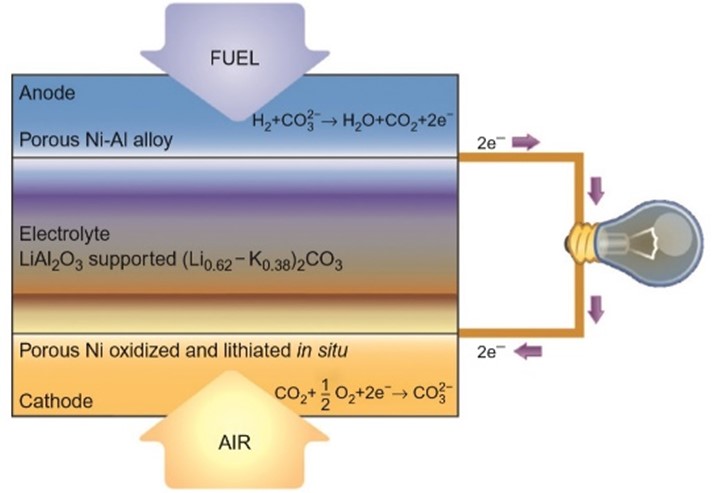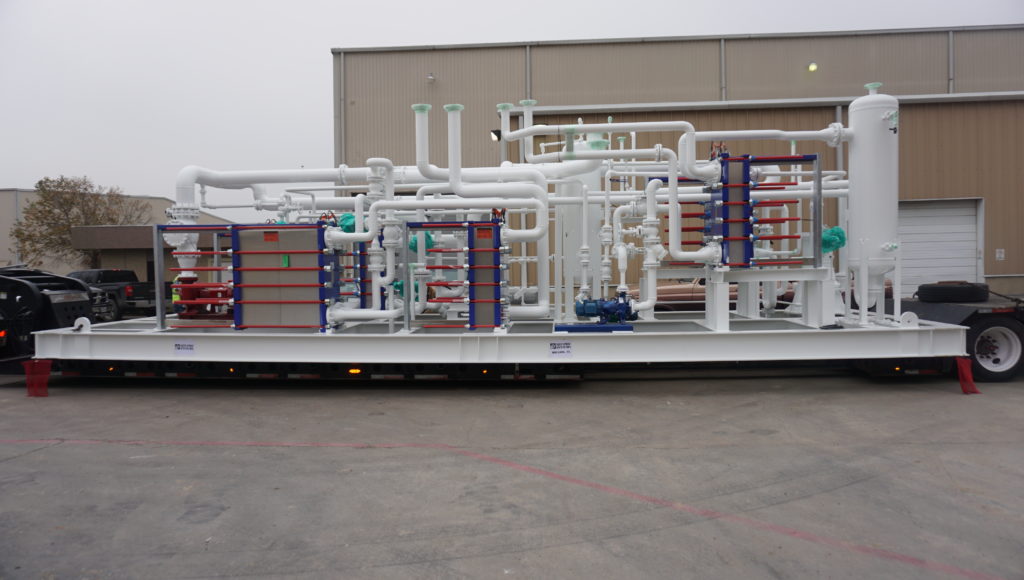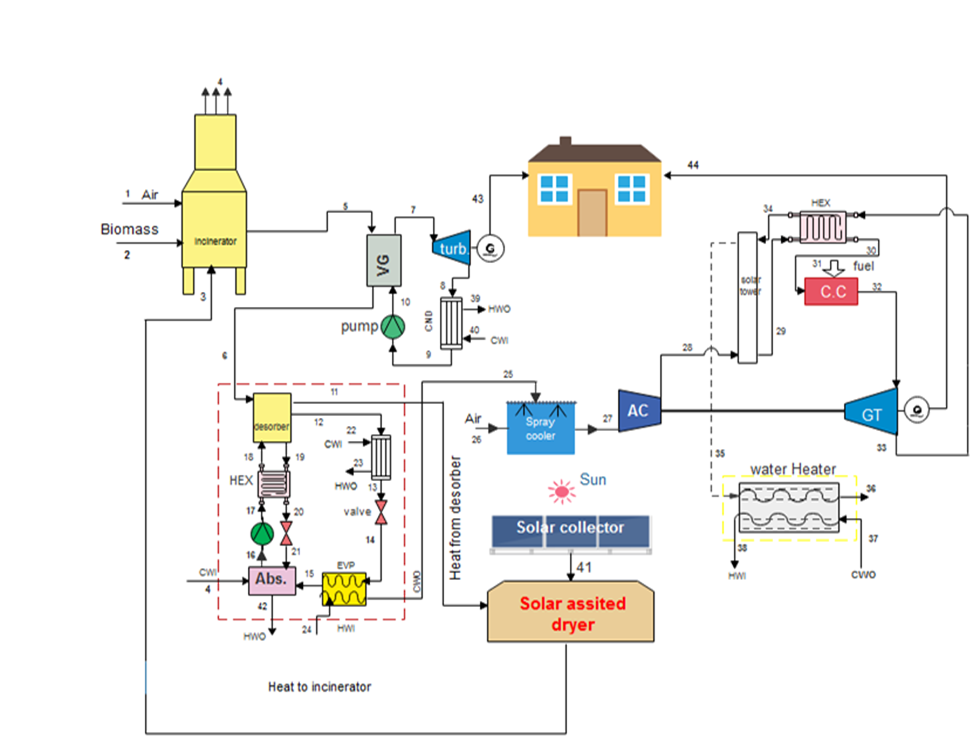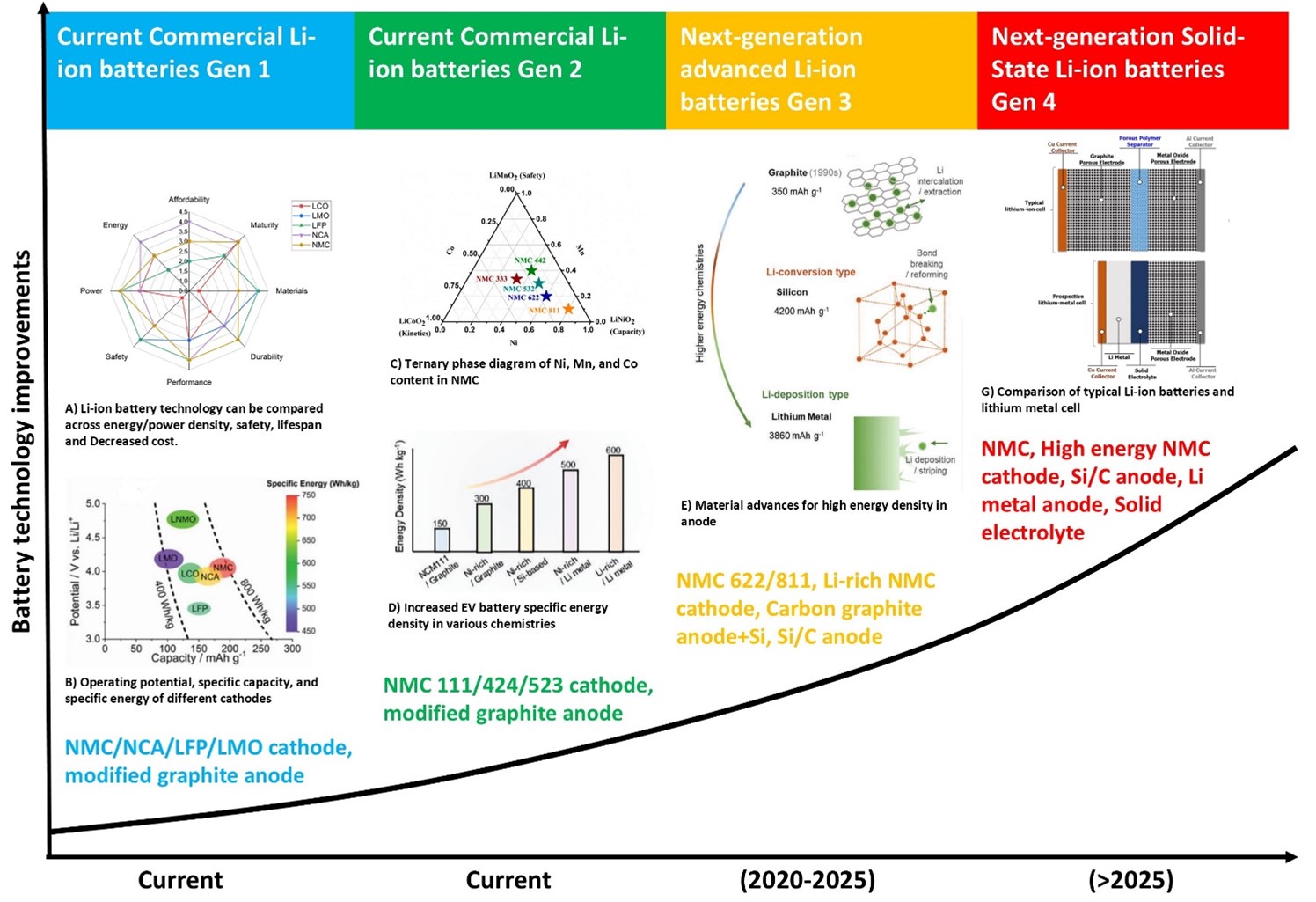A comprehensive review of alkaline fuel cells

Downloads
The alkaline fuel cell is known as the “bacon” fuel cell. It generates electricity through the chemical reaction without the emission of greenhouse gases. This will allow it to replace fossil fuels in the future. It produced only the water for the final product. It operates at a temperature of 25˚C to 250˚C, which is relatively low compared to the internal combustion engines. It has wide application in the modern industry. This is due to the system's high efficiency, reaching up to 60%. However, the alkaline fuel cell has several disadvantages, which affect to popularize. This paper contains a review of alkaline fuel cells, an extensive study of the components that make up the fuel cells, as well as the future applications and challenges of fuel cells. A comparison of alkaline fuel cells and other types of fuel cells has also been discussed in the paper. In addition to the research paper, future trends and forecasts will also be able to accurately predict the viability of implementing this technology in the near future.
B. Viswanathan, "Chapter 14 - Fuel Cells," in Energy SourcesAmsterdam: Elsevier, 2017, pp. 329-356.
F. Bidault, D. J. L. Brett, P. H. Middleton, and N. P. Brandon, "Review of gas diffusion cathodes for alkaline fuel cells," Journal of Power Sources, vol. 187, no. 1, pp. 39-48, 2/1/ 2009.
I. Verhaert, G. Mulder, and M. De Paepe, "Evaluation of an alkaline fuel cell system as a micro-CHP," Energy Conversion and Management, vol. 126, pp. 434-445, 10/15/ 2016.
I. Sprague and P. Dutta, "Role of the diffuse layer in acidic and alkaline fuel cells," Electrochimica Acta, vol. 56, no. 12, pp. 4518-4525, 4/30/ 2011.
M. Schulze, E. Gülzow, and G. Steinhilber, "Activation of nickel-anodes for alkaline fuel cells," Applied Surface Science, vol. 179, no. 1–4, pp. 251-256, 7/16/ 2001.
P. Yu Xu, K. Zhou, G. Lu Han, Q. Gen Zhang, A. Mei Zhu, and Q. Lin Liu, "Fluorene-containing poly(arylene ether sulfone)s as anion exchange membranes for alkaline fuel cells," Journal of Membrane Science, vol. 457, pp. 29-38, 5/1/ 2014.
"AFC Energy takes a back to basics, commercial approach," Fuel Cells Bulletin, vol. 2011, no. 11, pp. 12-13, 11// 2011.
M. C. a. K. Kordesch, W. Vielstich, A. Lamm, and H. A. Gasteiger, Eds. Hydrogen/oxygen (Air) fuel cells with alkaline electrolytes. Chichester, 2003, pp. 267–280.
X. Li, B. N. Popov, T. Kawahara, and H. Yanagi, "Non-precious metal catalysts synthesized from precursors of carbon, nitrogen, and transition metal for oxygen reduction in alkaline fuel cells," Journal of Power Sources, vol. 196, no. 4, pp. 1717-1722, 2/15/ 2011.
T. A. Sherazi, J. Yong Sohn, Y. Moo Lee, and M. D. Guiver, "Polyethylene-based radiation grafted anion-exchange membranes for alkaline fuel cells," Journal of Membrane Science, vol. 441, pp. 148-157, 8/15/ 2013.
I. P. Raya, M. W. Ellis, A. Hernandez-Guerrero, and F. Elizalde-Blancas, "Modeling the effect of membrane conductivity on the performance of alkaline fuel cells," Journal of Power Sources, vol. 307, pp. 898-906, 3/1/ 2016.
H. Deng, J. Chen, K. Jiao, and X. Huang, "An analytical model for alkaline membrane direct methanol fuel cell," International Journal of Heat and Mass Transfer, vol. 74, pp. 376-390, 7// 2014.
C. Weinzierl and U. Krewer, "Model-based analysis of water management at anode of alkaline direct methanol fuel cells," Chemical Engineering Science, vol. 143, pp. 181-193, 4/2/ 2016.
M. A. Hernández-Rodríguez, M. C. Goya, M. C. Arévalo, J. L. Rodríguez, and E. Pastor, "Carbon supported Ag and Ag–Co catalysts tolerant to methanol and ethanol for the oxygen reduction reaction in alkaline media," International Journal of Hydrogen Energy, vol. 41, no. 43, pp. 19789-19798, 11/16/ 2016.
M. Tomassetti, R. Angeloni, G. Merola, M. Castrucci, and L. Campanella, "Catalytic fuel cell used as an analytical tool for methanol and ethanol determination. Application to ethanol determination in alcoholic beverages," Electrochimica Acta, vol. 191, pp. 1001-1009, 2/10/ 2016.
E. Antolini and E. R. Gonzalez, "Alkaline direct alcohol fuel cells," Journal of Power Sources, vol. 195, no. 11, pp. 3431-3450, 6/1/ 2010.
F. Bidault, D. Brett, P. Middleton, and N. Brandon, "Review of gas diffusion cathodes for alkaline fuel cells," Journal of Power Sources, vol. 187, no. 1, pp. 39-48, 2009.
M. Piana et al., "H 2/air alkaline membrane fuel cell performance and durability, using novel ionomer and non-platinum group metal cathode catalyst," Journal of Power Sources, vol. 195, no. 18, pp. 5875-5881, 2010.
S. Sarangapani, P. Lessner, M. Manoukian, and J. Giner, "Non-noble electrocatalysts for alkaline fuel cells," Journal of power sources, vol. 29, no. 3-4, pp. 437-442, 1990.
K. Kordesch et al., "Alkaline fuel cells applications," Journal of Power Sources, vol. 86, no. 1–2, pp. 162-165, 3// 2000.
V. Paganin, E. Ticianelli, and E. Gonzalez, "Development and electrochemical studies of gas diffusion electrodes for polymer electrolyte fuel cells," Journal of Applied Electrochemistry, vol. 26, no. 3, pp. 297-304, 1996.
E. Gülzow, N. Wagner, and M. Schulze, "LONG TERM INVESTIGATIONS OF SILVER CATHODES FOR ALKALINE FUEL CELLS," in Conference Proceedings, 2002.
M. Lefèvre, E. Proietti, F. Jaouen, and J.-P. Dodelet, "Iron-based catalysts with improved oxygen reduction activity in polymer electrolyte fuel cells," science, vol. 324, no. 5923, pp. 71-74, 2009.
G. Merle, M. Wessling, and K. Nijmeijer, "Anion exchange membranes for alkaline fuel cells: A review," Journal of Membrane Science, vol. 377, no. 1, pp. 1-35, 2011.
R. A. Lemons, "Fuel cells for transportation," Journal of Power Sources, vol. 29, no. 1-2, pp. 251-264, 1990.
F. Bidault, D. Brett, P. Middleton, N. Abson, and N. Brandon, "An improved cathode for alkaline fuel cells," international journal of hydrogen energy, vol. 35, no. 4, pp. 1783-1788, 2010.
J. Hall and R. Kerr, "Innovation dynamics and environmental technologies: the emergence of fuel cell technology," Journal of Cleaner Production, vol. 11, no. 4, pp. 459-471, 2003.
K. P. Andreasen and B. K. Sovacool, "Hydrogen technological innovation systems in practice: comparing Danish and American approaches to fuel cell development," Journal of Cleaner Production, vol. 94, pp. 359-368, 2015.
U. Jameel, M. Zhu, W. Tikkanen, X. Chen, and Z. Tong, "Recent fuel cell progress in nano gold hybrid materials for oxygen reduction reaction in alkaline media," Materials Research Bulletin, vol. 84, pp. 185-211, 2016.
D. Cameron, R. Holliday, and D. Thompson, "Gold’s future role in fuel cell systems," Journal of Power Sources, vol. 118, no. 1, pp. 298-303, 2003.
L. An and R. Chen, "Recent progress in alkaline direct ethylene glycol fuel cells for sustainable energy production," Journal of Power Sources, vol. 329, pp. 484-501, 2016.
N. Bidin et al., "The effect of sunlight in hydrogen production from water electrolysis," International Journal of Hydrogen Energy, vol. 42, no. 1, pp. 133-142, 1/5/ 2017.
J. D. Holladay, J. Hu, D. L. King, and Y. Wang, "An overview of hydrogen production technologies," Catalysis Today, vol. 139, no. 4, pp. 244-260, 2009.
S. Markgraf, M. Hörenz, T. Schmiel, W. Jehle, J. Lucas, and N. Henn, "Alkaline fuel cells running at elevated temperature for regenerative fuel cell system applications in spacecrafts," Journal of Power Sources, vol. 201, pp. 236-242, 3/1/ 2012.
A. E. Lutz, R. S. Larson, and J. O. Keller, "Thermodynamic comparison of fuel cells to the Carnot cycle," International Journal of Hydrogen Energy, vol. 27, no. 10, pp. 1103-1111, 10// 2002.
G. Garage. (2015, April 23). 11 Big Advantages and Disadvantages of Hydrogen Fuel Cells. Available: https://greengarageblog.org/11-big-advantages-and-disadvantages-of-hydrogen-fuel-cells
B. Cox and K. Treyer, "Environmental and economic assessment of a cracked ammonia fuelled alkaline fuel cell for off-grid power applications," Journal of Power Sources, vol. 275, pp. 322-335, 2/1/ 2015.
H. S. Das, C. W. Tan, and A. H. M. Yatim, "Fuel cell hybrid electric vehicles: A review on power conditioning units and topologies," Renewable and Sustainable Energy Reviews, vol. 76, pp. 268-291, 9// 2017.
V. Nian, "Progress in Nuclear Power Technology," in Reference Module in Earth Systems and Environmental Sciences: Elsevier, 2017.
C. San Marchi et al., "Overview of the DOE hydrogen safety, codes and standards program, part 3: Advances in research and development to enhance the scientific basis for hydrogen regulations, codes and standards," International Journal of Hydrogen Energy, vol. 42, no. 11, pp. 7263-7274, 3/16/ 2017.
R. Wurster, "9 - Hydrogen safety: An overview A2 - Ball, Michael," in Compendium of Hydrogen Energy, A. Basile and T. N. Veziroğlu, Eds. Oxford: Woodhead Publishing, 2016, pp. 195-213.
K. Mazloomi and C. Gomes, "Hydrogen as an energy carrier: Prospects and challenges," Renewable and Sustainable Energy Reviews, vol. 16, no. 5, pp. 3024-3033, 6// 2012.
H. I. Villafán-Vidales, C. A. Arancibia-Bulnes, D. Riveros-Rosas, H. Romero-Paredes, and C. A. Estrada, "An overview of the solar thermochemical processes for hydrogen and syngas production: Reactors, and facilities," Renewable and Sustainable Energy Reviews, vol. 75, pp. 894-908, 8// 2017.
S. Koumi Ngoh and D. Njomo, "An overview of hydrogen gas production from solar energy," Renewable and Sustainable Energy Reviews, vol. 16, no. 9, pp. 6782-6792, 12// 2012.
J. Wang, "Barriers of scaling-up fuel cells: Cost, durability and reliability," Energy, vol. 80, pp. 509-521, 2/1/ 2015.
J. Wang, "Theory and practice of flow field designs for fuel cell scaling-up: A critical review," Applied Energy, vol. 157, pp. 640-663, 11/1/ 2015.
A. Lajunen and T. Lipman, "Lifecycle cost assessment and carbon dioxide emissions of diesel, natural gas, hybrid electric, fuel cell hybrid and electric transit buses," Energy, vol. 106, pp. 329-342, 7/1/ 2016.
X. LI, Taylor, and Francis, "Principles of fuel cells," 4 April 2017 2005. https://doi.org/10.1201/9780203942338
N. Belmonte et al., "A comparison of energy storage from renewable sources through batteries and fuel cells: A casestudy in Turin, Italy," 2016. https://doi.org/10.1016/j.ijhydene.2016.07.260
T. Jahnke, M. Zago, A. Casalegno, W. G. Bessler, and A. Latz, "A transient multi-scale model for direct methanol fuel cells," 4 April 2017 2017. https://doi.org/10.1016/j.electacta.2017.02.116
C. M, A. Melendez-Ceballos, and V. L. A. Ringuede, "Molten carbonate fuel cells," 4 April 2017 n.d. https://doi.org/10.1016/B978-1-78242-363-8.00003-7
D. E. Eapen, S. R. Suseendiran, and R. Rengaswamy, "Phosphoric acid fuel cells," 4 April 2017 n.d. https://doi.org/10.1016/B978-1-78242-363-8.00002-5
B.G. Pollet, A. A. Franco, H. Su, H. Liang, and S. Pasupathi, "Proton exchnage membrane fuel cells," 4 April 2017 n.d.https://doi.org/10.1016/B978-1-78242-363-8.00001-3
V. N. Nguyen and L. Blum, "Reversible fuel cells," 4 April 2017 n.d. https://doi.org/10.1016/B978-1-78242-363-8.00005-0
M. L. Faro, S. Trocino, S. C. Zignani, and A. S. Arico, "Solid oxide fuel cells," 4 April 2017 n.d. https://doi.org/10.1016/B978-1-78242-363-8.00004-9
L. van Biert, M. Godjevac, K. Visser, and P. V. Aravind, "A review of fuel cell systems for maritime applications," Journal of Power Sources, vol. 327, pp. 345-364, 9/30/ 2016.
G. Sattler, "Fuel cells going on-board," Journal of Power Sources, vol. 86, no. 1–2, pp. 61-67, 3// 2000.
A. Kulkarni and S. Giddey, "Materials issues and recent developments in molten carbonate fuel cells," Journal of Solid State Electrochemistry, journal article vol. 16, no. 10, pp. 3123-3146, 2012.
M. Krumpelt, R. Kumar, and K. M. Myles, "Fundamentals of fuel cell system in integration," Journal of Power Sources, vol. 49, no. 1, pp. 37-51, 1994/04/01 1994.
R. Dillon, S. Srinivasan, A. S. Aricò, and V. Antonucci, "International activities in DMFC R&D: status of technologies and potential applications," Journal of Power Sources, vol. 127, no. 1–2, pp. 112-126, 3/10/ 2004.
E. Gülzow, "Alkaline Fuel Cells," Fuel Cells, vol. 4, no. 4, pp. 251-255, 2004.
M. Eroglu, E. Dursun, S. Sevencan, J. Song, S. Yazici, and O. Kilic, "A mobile renewable house using PV/wind/fuel cell hybrid power system," International Journal of Hydrogen Energy, vol. 36, no. 13, pp. 7985-7992, 7// 2011.
E. H. Yu, X. Wang, U. Krewer, L. Li, and K. Scott, "Direct oxidation alkaline fuel cells: from materials to systems," Energy & Environmental Science, 10.1039/C2EE02552C vol. 5, no. 2, pp. 5668-5680, 2012.
K. Kordesch et al., "Intermittent use of a low-cost alkaline fuel cell-hybrid system for electric vehicles," Journal of Power Sources, vol. 80, no. 1–2, pp. 190-197, 7// 1999.
Y. Ma, G. G. Karady, A. Winston Iii, P. Gilbert, R. Hess, and D. Pelley, "Economic feasibility prediction of the commercial fuel cells," Energy Conversion and Management, vol. 50, no. 2, pp. 422-430, 2// 2009.
E. D. Wachsman, "Fuel cell future," Issues in Science & Technology, Article vol. 29, no. 4, pp. 10-11, Summer2013 2013.
J. Pan, S. Lu, Y. Li, A. Huang, L. Zhuang, and J. Lu, "High-Performance Alkaline Polymer Electrolyte for Fuel Cell Applications," Advanced Functional Materials, vol. 20, no. 2, pp. 312-319, 2010.
G. F. McLean, T. Niet, S. Prince-Richard, and N. Djilali, "An assessment of alkaline fuel cell technology," International Journal of Hydrogen Energy, vol. 27, no. 5, pp. 507-526, 5// 2002.
K. Sopian and W. R. W. Daud, "Challenges and future developments in proton exchange membrane fuel cells," 4 April 2017 2005.
K. Kordesch et al., "Alkaline fuel cells applications," 4 April 2017 1999.
D. a. f. c. t. a. u. o. platinum, "Daihatsu alkaline fuel cell technology avoids use of platinum," 4 April 2017 n.d.
J.-H. Wee, "Applications of proton exchange membrane fuel cell systems," 4 April 2017 2006.
S. Liu, X. Liu, Y. Wang, and P. Zhang, "Electricity generation from macroalgae enteromorpha prolifera hydrolysates using an anlkaline fuel cell," 4 April 2017 2016.
X. Liu, Z. Li, Y. Yang, P. Liu, and P. Zhang, "Electricity generation from a refuelable glucose alkaline fuel cell with amethyl viologen-immobilized activated carbon anode," 4 April 2017 2016.
E. Gülzow, "Alkaline fuel cells: a critical view," Journal of Power Sources, vol. 61, no. 1–2, pp. 99-104, 7// 1996.















